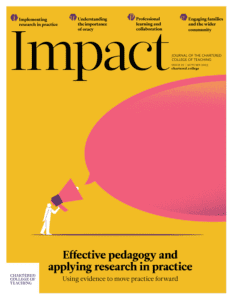Can we ever have ‘equity and equality’ in secondary digital education?
Written by: David Greenshields

7 min read
DAVID GREENSHIELDS FCCT, VICE PRINCIPAL, GRACE COLLEGE, UK
The COVID-19 pandemic, including the closure of schools within many Western nations in the spring of 2020, has accelerated the shift towards and heightened the awareness of many educational organisations in relation to digital learning environments and technologies, and this has persisted throughout the period of schools reopening and returning to face-to-face teaching. Blume argues that while almost every area of our daily lives experienced significant disruption as a consequence of the pandemic and the state’s response to it, the education sector was ‘one of the sectors most severely affected’ (2020, p. 3).
The enforced move to teaching and learning taking place by distanced, digital structures and the gradual reopening of society has led some to claim that the increased use of digital environments can lead to a transformation in education, not least in relation to the fostering of student wellbeing and ‘increasin
Join us or sign in now to view the rest of this page
You're viewing this site as a guest, which only allows you to view a limited amount of content.
To view this page and get access to all our resources, join the Chartered College of Teaching (it's free for trainee teachers and half price for NQTs) or log in if you're already a member.
- Blume C (2020) German teachers’ digital habitus and their pandemic pedagogy. Postdigital Science and Education 2: 879–905.
- Bourdieu P (1986) The forms of capital. In: Halsey AH, Lauder H, Brown P et al. (eds) Education: Culture, Economy and Society (1997). Oxford: Oxford University Press, pp. 241–258.
- Costa C, Hammond M and Younie S (2019) Theorising technology in education: an introduction. Technology, Pedagogy and Education 28(4): 395–399.
- Fullan M, Quinn J, Drummy M et al. (2020) Education reimagined: The future of learning. New Pedagogies for Deep Learning and Microsoft Education. Available at: http://aka.ms/HybridLearningPaper (accessed 19 July 2023).
- Gomez DC (2020) The third digital divide and Bourdieu: Bidirectional conversion of economic, cultural and social capital to (and from) digital capital among young people in Madrid. New Media and Society 23(9): 2534–2553.
- Gorski P (2005) Education equity and the digital divide. AACE Journal 13(1): 3–45.
- Iivari N, Sharma S and Ventä-Olkkonen L (2020) Digital transformation of everyday life – how COVID-19 pandemic transformed the basic education of the young generation and why information management research should care? International Journal of Information Management 55: 102183.
- Moltó Egea O (2014) Neoliberalism, education and the integration of ICT in schools: A critical reading. Technology, Pedagogy and Education 23(2): 267–283.
- OECD (2015) Students, Computers and Learning: Making the Connection. PISA. Paris: OECD Publishing. Available at: http://dx.doi.org/10.1787/9789264239555-en (accessed 19 July 2023).
- Ragnedda M (2018) Conceptualizing digital capital. Telematics and Informatics 35(8): 2366–2375.
- Ragnedda M (2019) Reconceptualising the digital divide. In: Mutsvairo B and Ragnedda M (eds) Mapping the Digital Divide in Africa: A Mediated Analysis. Amsterdam: Amsterdam University Press, pp. 27–43.
- Selwyn N (2004) Reconsidering political and popular understandings of the digital divide. New Media & Society 6(3): 341–362.
0
0
votes
Please Rate this content
Subscribe
Please login to comment
0 Comments
Oldest
Newest
Most Voted
Inline Feedbacks
View all comments










